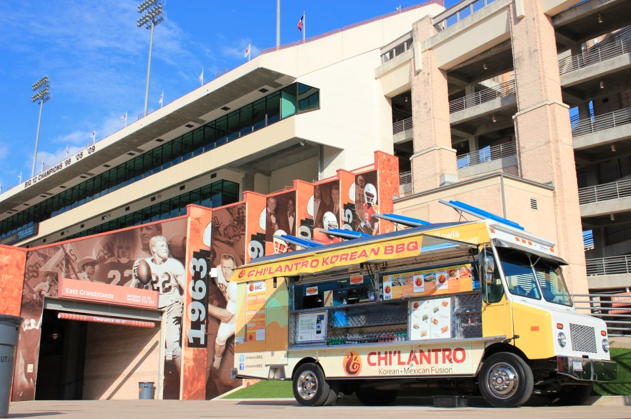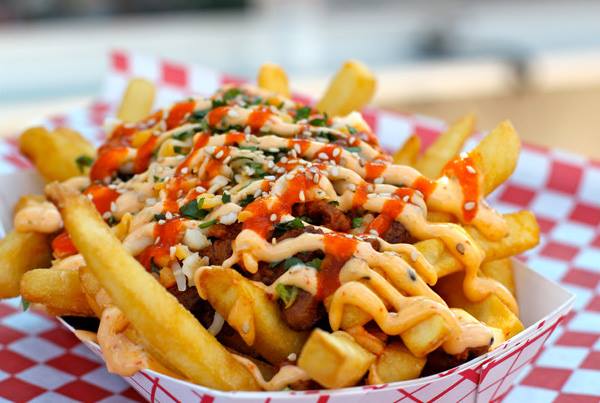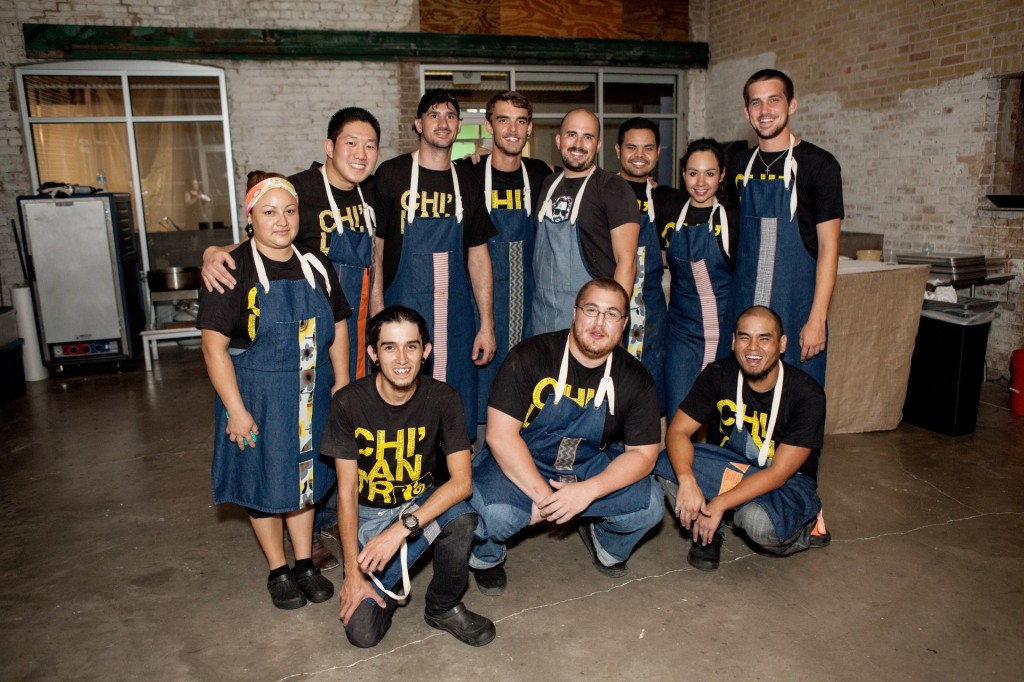- California Assembly OKs highest minimum wage in nation
- S. Korea unveils first graphic cigarette warnings
- US joins with South Korea, Japan in bid to deter North Korea
- LPGA golfer Chun In-gee finally back in action
- S. Korea won’t be top seed in final World Cup qualification round
- US men’s soccer misses 2nd straight Olympics
- US back on track in qualifying with 4-0 win over Guatemala
- High-intensity workout injuries spawn cottage industry
- CDC expands range of Zika mosquitoes into parts of Northeast
- Who knew? ‘The Walking Dead’ is helping families connect
Chi’Lantro truck has a Texas-sized hit in Kimchi fries
Just last month, 6,000 pounds of the vastly popular menu offering were sold

The Tex-Mex Korean fusion dish became so popular, it instantly put Chi’Lantro on the food truck map.
This is the second in a series featuring some of today’s most popular Korean food trucks in the U.S.
By Jane Han
AUSTIN — Imagine a heap of savory caramelized kimchi, a mound of sizzling bulgogi, chopped grilled onions, cheddar and Monterey Jack cheese, cilantro and sesame seeds all thrown on a bed of hot and crispy French fries, topped off with a generous drizzle of mayo spiked with Sriracha.

Jae Kim, a graduate of California State University in Fullerton, now runs five trucks in Austin and Houston.
Is your mouth watering yet? Go ahead, dig into Chi’Lantro’s original kimchi fries.
While Korean tacos are all the rage, the wildly popular Austin food truck has moved onto something even better – fries, on steroids.
The Tex-Mex Korean fusion dish became so popular, it instantly put Chi’Lantro on the competitive food truck map, right up against other mega mobile eateries across the U.S.
Now running five trucks in Austin and Houston, owner Jae Kim may come off as some kind of French fries master.
Well, he is now. But he told The Korea Times it happened all by chance.
“On one slow night in downtown Austin,” Kim recalled, ”I decided to experiment with food that wasn’t popular on my truck.”
“We threw away a lot of kimchi because people were intimidated by it, so I had to find a way to use it somehow,” he said. ”At that time, a lot of people didn’t know what kimchi was.”
And so, he put together kimchi — and yes — fries, once a dull side item on the menu, and voila!
“Something magical happened,” said Kim. ”People loved it. They just kept coming back.”
Last month alone, Chi’Lantro went through 6,000 pounds of fries, making the dish by far the best-selling item on Kim’s food truck and a lifesaver for his business, which started out by ringing up just $7 in sales the first day.
“I made $20 the next day,” said Kim, who had to throw out buckets of unsold food when he first opened Chi’Lantro in February 2010. ”It was definitely a slow start.”
Business didn’t go as expected, but despite pouring in everything he had — literally everything — Kim somehow managed to keep his cool.
“I started my company with loads of credit card debt. I took out all my savings plus some more,” said the 30-year-old, who was 26 at the time of opening. ”It was an all-in decision for me.”
“I worked 20 hours a day for a year and a half and it really wore me out physically and mentally, but I gained a life lesson that nothing in life is easy and you just have to work hard,” said Kim.
Perhaps his rather tough upbringing helped him ride out the rough beginning.
“I am a 1.5-generation who went through the visa problems, the IMF, and separation of family,” said Kim, who was born in Korea and moved to the U.S. when he was 11 years old.
After graduating from California State University in Fullerton, he opened his first food business at the age of 21.
It was at Kim’s coffee shop, the Foothill Café, which he owned for three years, where he discovered his love for food and the food business.
And after much thinking, Kim says he left for Austin, a culturally diverse destination, to start up his Korean-Mexican food truck Chi’Lantro, a portmanteau of ”kimchi” and “cilantro.”
“Running a food truck is not an easy job,” says the owner, who now manages dozens of staff. ”When you first start, you have to be a mechanic, you have to be a real estate expert, you have to prep, cook, wash dishes, wash the car, manage people, and do accounting at the end of the day.”
But after four years of operation, Kim says it’s all worth it when you see your business in places you’ve only dreamed of.
“It’s pretty awesome when Chi’Lantro gets featured in all the media channels and magazines I would’ve never imagined being in,” said Kim, whose fries has been featured on The Food Network, Travel Channel and Food & Wine magazine, to name a few.
He says, in 10 years, he hopes to expand his growing fleet to up to 50 units.
“Hospitality business is all about people,” says Kim. ”Our customers and staff believe we can make it happen. We have one customer who tweets our schedule on their Twitter feed. We have customers who come to all our events. How great is that?”


















